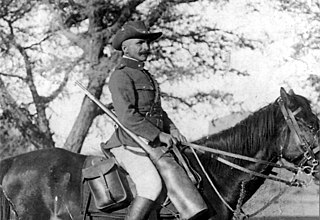
Khoekhoen are the traditionally nomadic pastoralist indigenous population of southwestern Africa. They are often grouped with the hunter-gatherer San peoples. The designation "Khoekhoe" is actually a kare or praise address, not an ethnic endonym, but it has been used in the literature as an ethnic term for Khoe-speaking peoples of Southern Africa, particularly pastoralist groups, such as the !Ora, !Gona, Nama, Xiri and ǂNūkhoe nations.

Lüderitz is a town in the ǁKaras Region of southern Namibia. It lies on one of the least hospitable coasts in Africa. It is a port developed around Robert Harbour and Shark Island.

The ǁKaras Region is the southernmost, largest, and least densely populated of the 14 regions of Namibia; its capital is Keetmanshoop. The name assigned to the region reflects the prominence of the Karas mountain range in its southern part. The ǁKaras region contains the municipality of Keetmanshoop, the towns Karasburg, Lüderitz and Oranjemund, and the self-governed villages Aroab, Berseba, Bethanie, Koës and Tses.

Keetmanshoop is a town in the ǁKaras Region of southern Namibia, lying on the Trans-Namib Railway from Windhoek to Upington in South Africa. It is named after Johann Keetman, a German industrialist and benefactor of the city.

Nama are an African ethnic group of South Africa, Namibia and Botswana. They traditionally speak the Nama language of the Khoe-Kwadi language family, although many Nama also speak Afrikaans. The Nama People are the largest group of the Khoikhoi people, most of whom have disappeared as a group, except for the Namas. Many of the Nama clans live in Central Namibia and the other smaller groups live in Namaqualand, which today straddles the Namibian border with South Africa.

TransNamib Holdings Limited, commonly referred to as TransNamib, is a state-owned railway company in Namibia. Organised as a holding company, it provides both rail and road freight services, as well as passenger rail services. Its headquarters are in the country’s capital Windhoek.

Warmbad is a settlement located in the ǁKaras Region of southern Namibia. It is situated south of Karasburg at the Homs River, close to the border with South Africa, and belongs to the Karasburg electoral constituency.

Aus is a settlement in the ǁKaras Region of southern Namibia. It lies on a railway line and the B4 national road, 230 km west of Keetmanshoop and about 125 km east of Lüderitz and belongs to the ǃNamiǂNûs electoral constituency. Trains from Keetmanshoop now end their journey at the village but formerly continued on to Lüderitz. The settlement is small but has a number of amenities including a hotel, police station, shop and garage. It is located in the Aus Mountains above the plains of the Namib Desert. The climate is usually hot and arid but snow has been recorded in the winter of 1963, and the area features the coldest winters recorded in Namibia.

The Battle of Sandfontein was fought between the Union of South Africa on behalf of the British Imperial Government and the German Empire on 26 September 1914 at Sandfontein, during the first stage of the South West Africa Campaign of World War I, and ended in a German victory.
Seeheim is a settlement in the ǁKaras Region of southern Namibia. The only notable structures in Seeheim today are the hotel and the railway station; only a handful of people live there. Seeheim belongs to the Keetmanshoop Rural electoral constituency.

Windhoek railway station is a railway station serving the city of Windhoek, the capital of Namibia. It is an important station in the Namibian rail network, and it is run by TransNamib.

Seeheim railway station is a railway station serving the settlement of Seeheim in southern Namibia. It is part of the TransNamib Railway, and is located along the line that leads from Windhoek southwards.

Lüderitz railway station is a railway station serving the town of Lüderitz in Namibia. It was erected in 1904.

Wilhelm Sander was a master architect and contractor working for Sander & Kock known for his work in German South West Africa, today's Namibia.

Grasplatz is a defunct railway station in the south of Namibia on the currently decommissioned Aus–Lüderitz line. It is the place where in 1908 railway worker Zacharias Lewala found the first diamond in German South-West Africa and handed it over to his foreman August Stauch. Stauch's subsequent investigation triggered a diamond rush.

Legislative elections were held for the first time in the territory of South West Africa on 26 May 1926. The German League in South West Africa won eight of the twelve elected seats in the Whites-only election.

Legislative elections were held in South West Africa on 3 July 1929. The whites-only election saw a victory for the United National South West Party, which won seven of the twelve elected seats in the Legislative Assembly.

Rail service in Namibia is provided by TransNamib. The Namibian rail network consists of 2,687 route-km of tracks (2017).

The Imperial Schutztruppe for German South West Africa was the official name of the military formation that maintained the German Empire in its colony of German South West Africa. The Schutztruppe are held responsible for numerous atrocities in the Herero and Nama uprising in 1904. During the First World War, the Schutztruppe was defeated by the troops of the Union of South Africa.



















